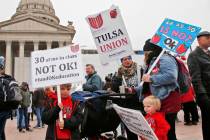Mortician who had political role is Garrison Street’s suspected namesake
Many Las Vegas streets are named for controversial people, according to Michael Green, a history professor at the College of Southern Nevada.
However, it’s possible that Garrison Street near Washington Avenue and Decatur Boulevard was named for Howell C. Garrison, a former Las Vegas mayor who took office to keep peace.
“I’m not clear if this is who the street was named after, but it was the choice that seemed most likely,” said Mark Hall-Patton, Clark County Museum administrator. “The neighborhood has been developed for a while, so it could easily be named after him, but there’s nothing that specifically states so.”
Born in Georgia, Garrison and his wife moved to Boulder City during the construction of Hoover Dam in the early 1930s, according to Hall-Patton.
“His job was to move the cemetery that would be covered by the waters backed up by the dam or what is now Lake Mead,” Hall-Patton said. “He finished that job in 1936 and purchased a mortuary in Boulder City and one in Las Vegas.”
Garrison worked as a local mortician until he was asked to fill in as mayor after John L. Russell was removed from office in 1941.
Russell, who served from 1939 to 1941, stirred up “quite a bit of trouble,” according to Green.
“John Russell was a controversial person and not in the way that many others have been,” Green said. “Everyone expected a lot of calmness out of him because he was a conservative, but he was anything but calm.”
As part of the Las Vegas Taxpayers League, Russell advocated for a lower tax rate in Las Vegas; however, the city commissioners did not agree with him.
“They ended up shouting at each other, suing each other and, at one point, Russell resigned,” Green said. “Then he came back claiming he hadn’t really resigned. He announced the commissioners committed malfeasance, and said they had to leave office.”
The original board of commissioners resigned en masse and elected one of its own as mayor; Russell appointed a new board of his own. During this time, Las Vegas operated under two city governments.
“Most people think one government body is too many,” Green said. “This was really an interesting time.”
For a few months, both boards and mayors met at the city hall simultaneously, with the city clerk running between the groups to keep record, according to Green.
“Eventually, one of the old commission members filed malfeasance charges against Russell,” Green said. “The board convicted him on eight counts and removed him from office in May 1941.”
Russell died two months later from a heart attack on Mount Charleston, and the original board elected member Herbert Krause to serve as interim mayor.
“It ended the argument, I guess,” Green said. “It turns out when he took office, he advocated for municipally owned utilities, something he had attacked earlier. He was what you would call a flip-flopper.”
Krause served only two weeks in office before Garrison was appointed mayor, Hall-Patton said.
“Garrison basically said, ‘OK, I’ll do it to calm things down for a few years,’ ” Hall-Patton said. “After his two years was up, he announced he would not be running in the next election and left the mayoral slot.”
In 1946, Garrison moved to Kansas to purchase another mortuary, according to Hall-Patton.
“An undertaker becoming mayor is an interesting concept,” Hall-Patton said, “but he left as quickly as he came.”
Green said Garrison isn’t mentioned in a lot of history books, but there might be a reason for that.
“People remember those who create controversy but never those who clean it up,” he said.
Contact Southwest View reporter Caitlyn Belcher at cbelcher@viewnews.com or 702-383-0403.















